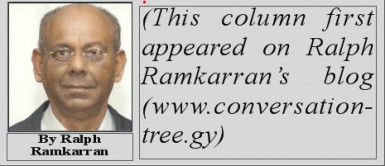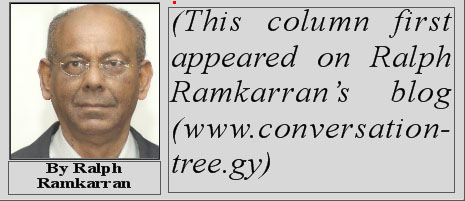As expected, the events at Babu John attracted wide attention and media coverage. A front page photograph in SN of President Ramotar belting out Bob Marley’s ‘Let’s Get Together’ was in striking contrast to the accusation by Dr Bharrat Jagdeo that during the 2011 elections, the opposition APNU had sent drummers around and had used racial remarks. Observers heard these two discordant notes, one a plea for unity in song, the other a divisive rant, and several others this past week.
The accusation against the PNCR created a storm and at press appearances, Dr Jagdeo sought to defend his remarks. The PPP’s complaint is that it is treated unfairly. The media, it claims, focuses on the PPP and ignores the PNC’s historic appeal to racism. The fact is that when either political party appeals to its supporters to vote for its party, in whatever language, it is an appeal that is alleged to be directed to one ethnic group. In Guyana the appeal can easily appear to be overtly ethnic or be interpreted as such. It is the PPP that has borne the burden of these accusations. But if the PPP is guilty, so is APNU. Both parties have relied on, and sought to ensure at every election, their solid blocs of ethnic support, while publicly encouraging cross-over voting.
The PPP rightly bristles at the general lack of specifics in accusations and at allegations that race campaigns are carried out at bottom house meetings. I have addressed hundreds of these over the years and not once have I ever made, or have been asked to make, or have heard a fellow speaker make, an appeal based on race. The strategy of the bottom house meeting developed during the dictatorship when permission for public meetings was grudgingly granted, if at all, and if granted was frequently broken up violently.
 Permission for bottom house meetings was not required. Even though many were still invaded by police and broken up, they still offered a modicum of safety. By the end of the dictatorship, bottom house meetings had become an integral organizational tool. Because no one in the PPP, including me up to the time I was there, ever thought to invite the press to these meetings, what was said has never been reported and the bottom house meetings have therefore been given a sinister image. The PNC, during its days in power, never had to rely on bottom house meetings as a defensive measure, and consequently this mode of mobilization was never deployed.
Permission for bottom house meetings was not required. Even though many were still invaded by police and broken up, they still offered a modicum of safety. By the end of the dictatorship, bottom house meetings had become an integral organizational tool. Because no one in the PPP, including me up to the time I was there, ever thought to invite the press to these meetings, what was said has never been reported and the bottom house meetings have therefore been given a sinister image. The PNC, during its days in power, never had to rely on bottom house meetings as a defensive measure, and consequently this mode of mobilization was never deployed.
Dr Jagdeo then used the press conference to defend his Cadillac style living in an opulent mansion by the sea by pathetically invoking what he alleges was Cheddi Jagan’s mansion in Bel Air. In the 1960s, Plantation Bel Air, as it was then known, where Cheddi Jagan’s house is located and where my parents were born, was a poor community of mainly small artisans, farm and city labourers and subsistence cattle and vegetable farmers. Cheddi Jagan’s land, next door to where I was born, grew up and still live, was acquired for $2,000 in the early 1960s.
Around that time Belvoir Court, which had been farming land of which my grandparents from both sides had tiny, rented plots from which they eked out a bare living, was acquired by the retiring Scottish Manager of the Bookers-owned Bel Air Estates Limited. It was surveyed in house lots and sold at moderate prices. It was empty land in the 1960s when Cheddi Jagan got his land.
In any event, the house that he constructed consisted of only an upper flat of three bedrooms, a tiny study, a small living room and kitchen, modest by the standards of that time or any standards. It is there for anyone to see. The impression given by Dr Jagdeo that Cheddi Jagan built a mansion, at the time comparable to his own, in an existing exclusive area is completely false and disingenuous.
That the PPP allows Dr Jagdeo’s false claims against its revered leader, dragging the latter down to his level, to go unchallenged is a manifestation of his overweening dominance of the PPP’s agenda and narrative and its destructive character. But is anyone surprised? He publicly attacked Mrs Jagan and no one came to her defence. When I returned from overseas, where I was at the time, Mrs Jagan refused to give me permission to respond.
Had Mrs Jagan been alive, she would have forbidden me to write what comes hereafter, being aspects of her and her husband’s personal lives that she would have wanted to remain private. But I know that this is in the interests of the PPP that Cheddi Jagan left behind in 1997, so I take the liberty.
Throughout the 1970s Dr and Mrs Jagan were often seen at modest restaurants around Georgetown on Saturday evenings. Dining out was one of their few pleasures. This, as well as Mrs Jagan’s visits to the hairdresser, stopped during the 1980s because they could no longer afford it. When Dr Jagan was diagnosed with a heart ailment, local facilities were then inadequate and he needed to seek medical attention overseas. He was awaiting a foreign trip that had already been planned so as to avoid the state having to pay for two trips. Unfortunately, his heart unexpectedly gave way before he could travel. But imagine Dr Jagan electing to go on a private jet trip, even on a free ride, for any reason, including medical attention! It is a sin for Bharrat Jagdeo to use the example of Cheddi Jagan to justify his mansion, his pension and his Cadillac lifestyle.
Uncomfortably close to Babu John with its approbation of kicking the opposition’s asses, Courtney Crum-Ewing was cruelly gunned down in a barbaric act that many believe could only be politically motivated. While it is necessary for the police investigation to be completed, I join the rest of Guyana in extending my condolences to the Crum-Ewing family, relatives and friends. The call for calm by prominent persons and groups should be supported while voices against this atrocity, committed while a citizen of our country was exercising the right of free speech, must be heard.






